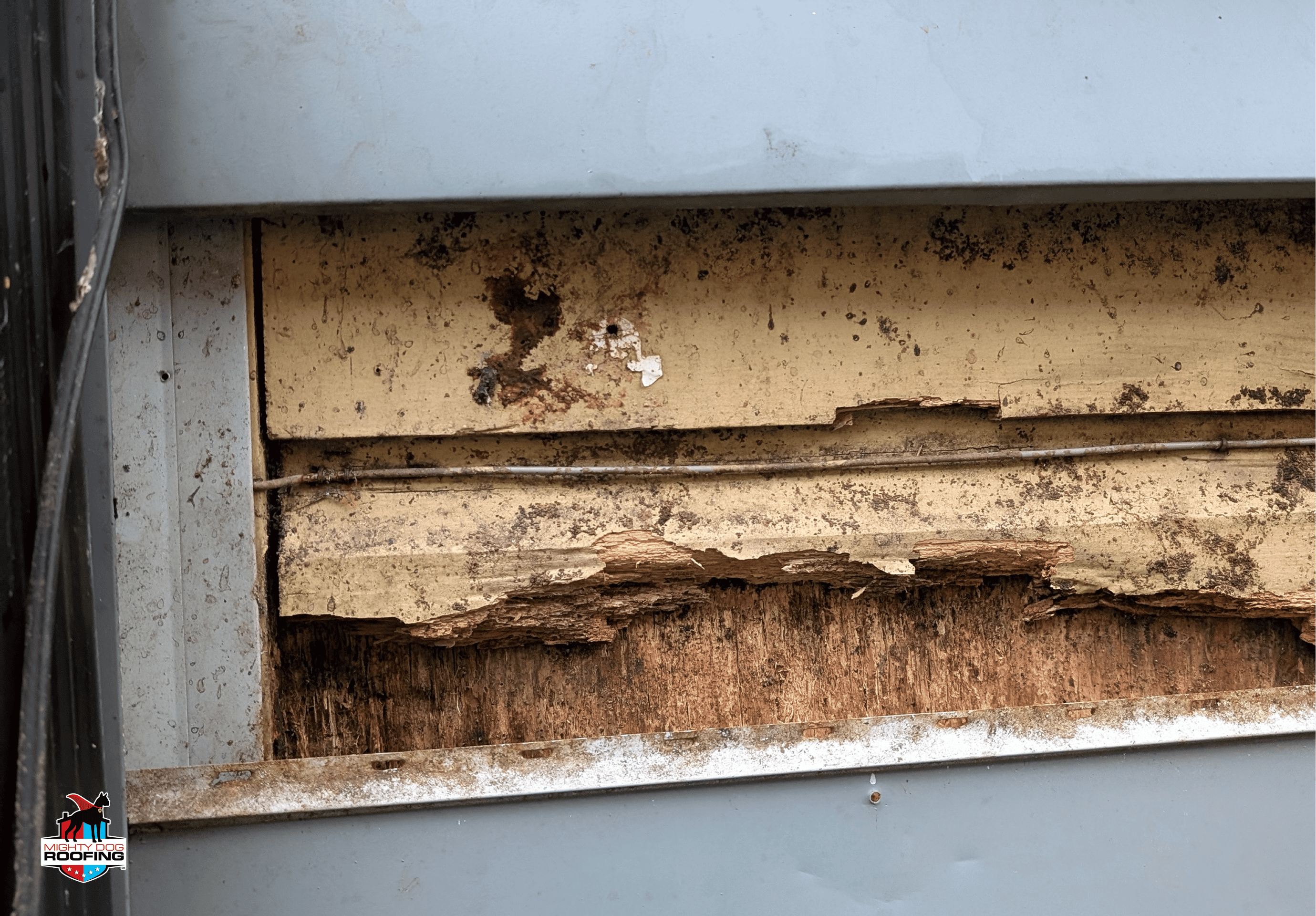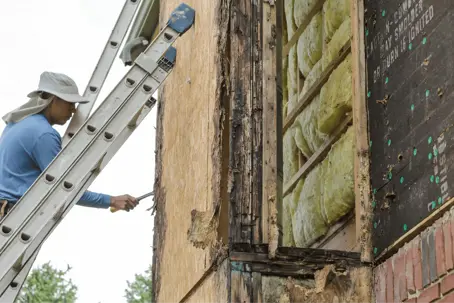Hidden degradation lurking beneath exterior surfaces poses a serious challenge for Pennsylvania property owners, frequently progressing unnoticed until extensive harm has already taken hold. The distinctive weather patterns throughout Chester County generate perfect environments for material breakdown underneath apparently undamaged exteriors. This detailed resource assists property owners in recognizing initial indicators, grasping rehabilitation methods, and establishing protective strategies prior to compromising the building's framework, safeguarding your property value against wood rot behind siding over the long term.
Early Warning Signs of Wood Rot Behind Siding
Recognizing degradation in its initial phases could prevent Pennsylvania property owners from spending significant amounts on rehabilitation work. External indicators frequently manifest gradually prior to severe framework complications developing. Watch for areas that seem distorted or protruding from the building structure—such conditions usually suggest hydraulic force from the interior. Paint that is peeling or bubbling, especially near joints and connections, often indicates water penetration rather than just typical aging. During your investigation of possible concerns, focus particularly on zones where liquid could accumulate or different components connect along your property's facade.
Warning Signs of Deterioration in Pennsylvania Homes:
Indicator | What to Look For | Severity Level |
Bulging Sections | Areas pushing outward from the wall | Medium-High |
Paint Failure | Peeling or bubbling in specific patterns | Medium |
Softened Materials | Spots that yield when pressed firmly | High |
Insect Activity | Ants or termites near material joints | Medium |
Discoloration | Dark staining or visible fungal growth | Medium-High |
An additional significant indicator requiring attention involves heightened pest presence, especially carpenter ants or termites, near intersections and connection points. Such insects gravitate toward previously weakening components, and finding them generally suggests degradation has advanced past early phases. While looking for local siding contractors near you, select seasoned experts who recognize these nuanced signs and can conduct comprehensive evaluations prior to major structural wood rot damage developing.

How Pennsylvania Weather Accelerates Wood Rot
Moisture Sources in Chester County Homes
The Pennsylvania environment establishes numerous routes for liquid to penetrate underneath external layers. During cold seasons, ice dams near the roof edge can push melting snow and water beneath the shingles and down the facade, creating hidden pathways for moisture under the exterior layers. Malfunctioning drainage systems worsen these conditions through permitting liquid to flow straight along structures or rebound from surfaces underneath.
Surface rebound proves especially challenging for Chester County properties, since our frequent precipitation creates ongoing liquid contact with base structure areas. Such perpetual dampening, paired with vapor becoming confined inside structure spaces, establishes optimal circumstances for degradation formation. Expert Pennsylvania siding rot assessment frequently uncovers these concealed liquid flows that property owners could overlook while attempting to comprehend the wood rot repair cost consequences.
Temperature Cycles and Wood Degradation
The significant seasonal thermal variations in Pennsylvania generate difficult circumstances for construction components. Our recurring freeze-thaw cycles cause the building materials to repeatedly swell and shrink, forming tiny cracks that allow water to enter the structure. After this liquid gets confined underneath defensive layers, escape becomes difficult because contemporary building methods reduce airflow inside structure spaces.
Warm season temperatures subsequently intensify degradation dramatically, since readings from 70-90°F establish optimal environments for fungal proliferation. This clarifies why detecting wood rot Pennsylvania properties necessitates comprehending our distinctive local climate conditions and their effects on construction components.
Areas Most Vulnerable in Pennsylvania Homes
Specific zones within Pennsylvania properties encounter elevated degradation hazards because of their contact conditions and building specifications. Base structure areas positioned 8-12 inches from ground level regularly experience increased liquid exposure through surface rebound, precipitation buildup, and garden watering. Such areas frequently display initial siding wood rot signs, especially along northern exposures receiving reduced evaporative solar exposure.
Opening and entry frame zones constitute additional weak spots where various components connect and form possible liquid access routes. Edge trim and connection channels likewise establish junction zones where liquid might enter and get confined. Expert evaluations often discover these connection areas demand special focus throughout both upkeep and rehabilitation work. Property owners pursuing Chester County siding repair must verify these susceptible zones obtain complete expert analysis from professionals who comprehend the distinct difficulties of Pennsylvania's environment and building practices.
Detection Methods and Inspection Techniques
Successful degradation identification demands visual examination combined with technical evaluation methods. Externally, review facades for shade variations, distortion, or atypical marking formations, especially following precipitation. Within your property, search for liquid marks along interior surfaces or filling materials neighboring external structures, potentially suggesting liquid infiltration via defensive components and possible wood rot behind siding concerns forming.
Key Inspection Areas for Detecting Deterioration:
- Base structure areas experiencing rebound contact.
- Near opening and entry frameworks.
- Beneath projections and extensions.
- At junctions with rooftop systems or barriers.
- Zones displaying visible coating breakdown or shade changes.
To achieve detailed evaluation, professional measurement tools deliver numerical readings of liquid levels within base materials. Such reasonably-priced instruments can detect abnormal dampness prior to apparent degradation emerging. While examining questionable zones, employ an implement to carefully check suspicious locations—if penetration occurs readily, degradation has probably started and wood rot prevention actions need immediate application. Knowledgeable regional professionals deliver thorough evaluations merging these methods alongside expert understanding, supplying property owners comprehensive reviews that could avoid expensive framework rehabilitation later.
Wood Rot Repair Process and Costs
Resolving degradation underneath facade layers demands an organized strategy starting with complete evaluation of harm severity. Expert siding repair contractors need to establish if degradation stays surface-level or has advanced into framework support components. Such vital analysis establishes if limited rehabilitation will work or whether broader framework correction becomes required for managing Pennsylvania siding rot issues.
Restoration Steps:
- Extract compromised facade components.
- Evaluate base material status and framework stability.
- Substitute degraded parts and condition adjacent zones.
- Place liquid defenses and adequate barriers.
- Install replacement facade components using corresponding materials.
- Add defensive coatings and treatments.
The wood rot repair cost within Pennsylvania properties generally spans $500-2,500 for focused rehabilitation to $5,000-15,000 for broad structural wood rot damage correction. Such expenses fluctuate according to reachability, components required, and if framework elements need substitution. Trustworthy professionals supply comprehensive evaluations revealing complete rehabilitation requirements prior to commencing, guaranteeing property owners grasp the entire wood rot repair process and related costs.

Preventing Rot in New Siding Installations
Successful wood rot prevention starts when placing fresh facade networks. Contemporary liquid-blocking layers, correctly positioned barrier components, and airflow spaces can significantly minimize liquid buildup underneath defensive components. Choosing inherently degradation-immune materials or manufactured products enhanced with protective treatments delivers extra defense from Pennsylvania's demanding environmental factors while minimizing subsequent Chester County siding repair requirements.
Correct installation methods are crucial, as the wood rot that Pennsylvania professionals frequently discover often stems from poor original placement. Mighty Dog Roofing of Greater West Chester guarantees sufficient spacing among facades and rooftop systems, correct component layering, and suitable closure around every opening and junction. Such placement specifications determine if networks endure multiple decades or deteriorate early displaying siding wood rot signs after merely several seasons. For property owners worried regarding framework stability, protective placement approaches constitute the greatest value extended-duration answer.
Protecting Your Pennsylvania Home Investment
Your property constitutes your primary financial asset, rendering forward-thinking upkeep vital for avoiding expensive rehabilitation. Arranging yearly expert evaluations with Mighty Dog Roofing of Greater West Chester assists in discovering possible concerns prior to their expansion into significant framework complications needing comprehensive wood rot repair process responses. Pairing such evaluations alongside consistent drainage maintenance, immediate rehabilitation of compromised areas, and sustaining adequate water diversion from your property's base establishes thorough protection from degradation within Pennsylvania's demanding environment.


